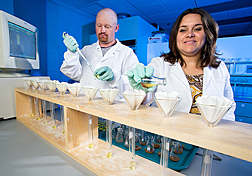This page has been archived and is being provided for reference purposes only. The page is no longer being updated, and therefore, links on the page may be invalid.
|
Read the magazine story to find out more. |
|
|
|
|
Study by ARS Microbiologist in Texas Shows Farming Practices’ Benefits to Soil Quality
By Don Comis
August 7, 2009
The first evaluation of alternative farming practices—based on changes in soil microbes—in the Texas High Plains has been done by an Agricultural Research Service (ARS) scientist.
Soil microbiologist Veronica Acosta-Martinez has also done a similar analysis for land in USDA's Conservation Reserve Program (CRP), a first nationally. Changes in microbes can give a relatively early indication as to whether an alternative practice is helping or hurting soil quality, which is important for plant productivity.
Acosta-Martinez, at the ARS Wind Erosion and Water Conservation Unit in Lubbock, has seen microbial communities respond within a few years to changes in land use or cropping systems, while it can take 10 years or more for changes to occur in other soil properties.
Since 2006, she and Ted Zobeck, an ARS soil scientist at Lubbock, have been taking soil samples from many farms participating in the Texas Alliance for Water Conservation (TAWC). The Alliance is part of a broad study in the Ogallala Aquifer region on the effect of farming practices on soil and water conservation.
It is a partnership with farmers, ranchers, industry, the High Plains Underground Water Conservation District No. 1, government agencies, and researchers from ARS, Texas Tech University, and The Texas A&M University System's AgriLife Research.
The Alliance studies 3,954 acres of farmland as well as CRP grasslands.
Microbes-bacteria, fungi and protozoa-release enzymes that drive the important carbon, nitrogen, phosphorus and sulfur cycles in soil and help form organic matter.
Acosta-Martinez found that CRP encouraged an increase in microbial diversity and activity, as did pastures and crop rotations. These changes are precursors to eventual increases in overall soil carbon content.
Read more about this research in the August 2009 issue of Agricultural Research magazine.
ARS is the principal intramural scientific research agency in the U.S. Department of Agriculture.

